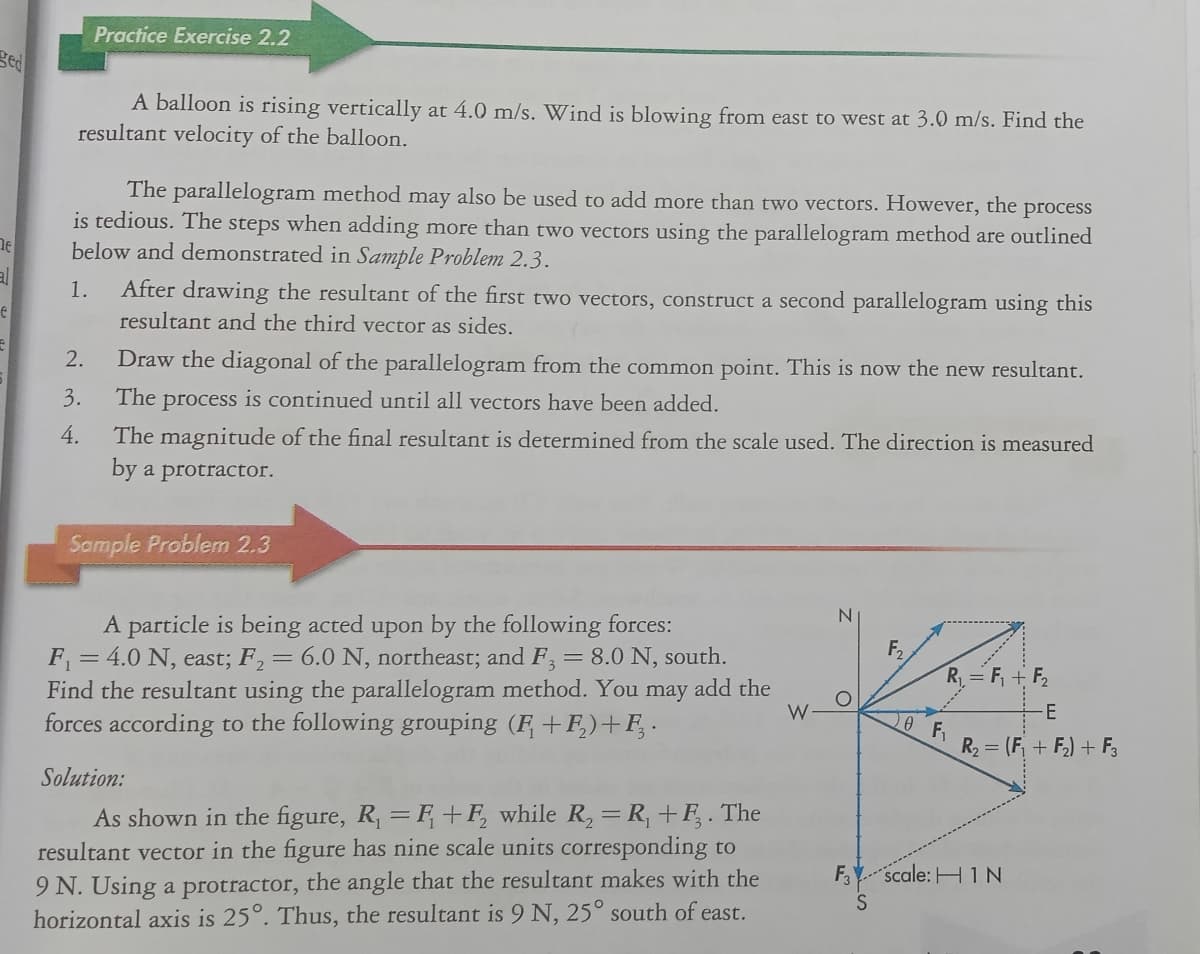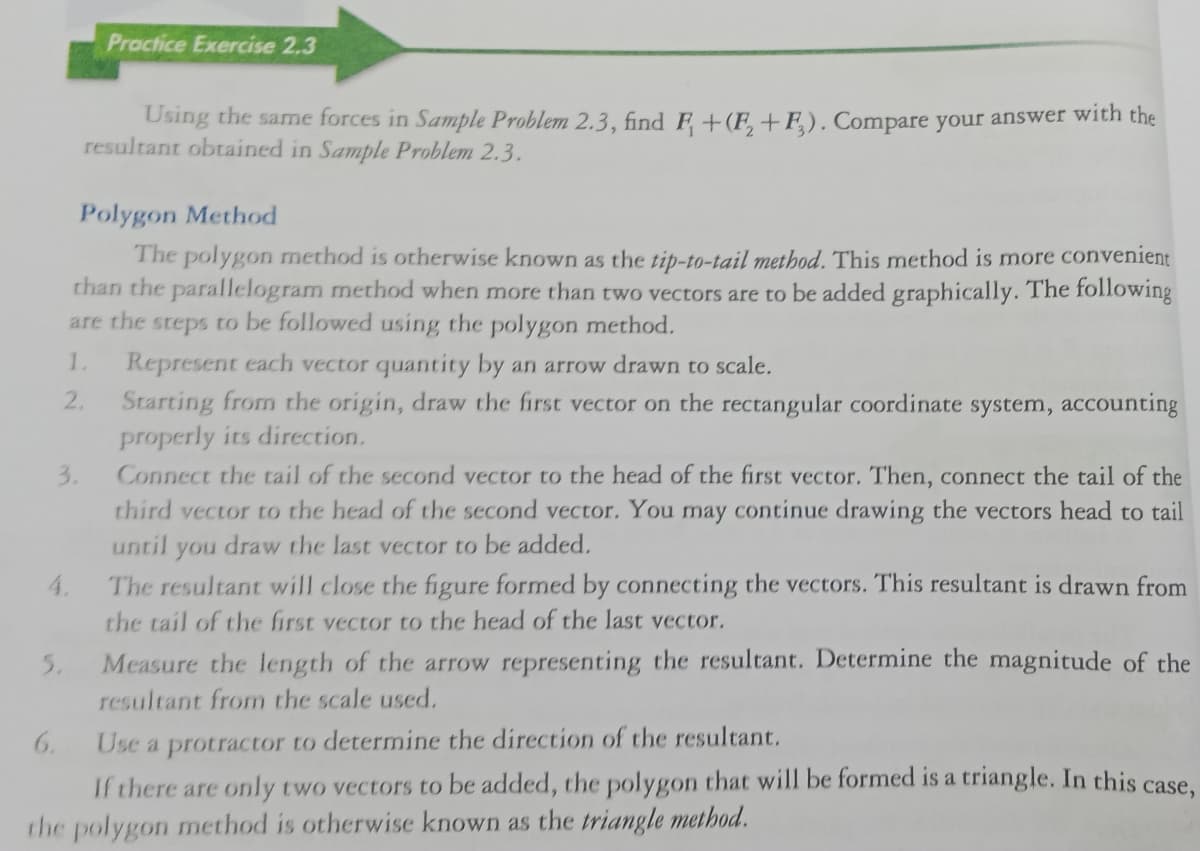Practice Exercise 2.2 A balloon is rising vertically at 4.0 m/s. Wind is blowing from east to west at 3.0 m/s. Find the resultant velocity of the balloon. The parallelogram method may also be used to add more than two vectors. However, the process is tedious. The steps when adding more than two vectors using the parallelogram method are outlined below and demonstrated in Sample Problem 2.3. 1. After drawing the resultant of the first two vectors, construct a second parallelogram using this resultant and the third vector as sides. 2. 3. 4. Draw the diagonal of the parallelogram from the common point. This is now the new resultant. The process is continued until all vectors have been added. The magnitude of the final resultant is determined from the scale used. The direction is measured by a protractor. Sample Problem 2.3 A particle is being acted upon by the following forces: F₁ = 4.0 N, east; F₂ = 6.0 N, northeast; and F3 = 8.0 N, south. Find the resultant using the parallelogram method. You. may add the forces according to the following grouping (F+F₂)+F₂. W Solution: As shown in the figure, R₁ = F +F₂ while R₂ = R₁ +F3. The esultant vector in the figure has nine scale units corresponding to N. Using a protractor, the angle that the resultant makes with the orizontal axis is 25°. Thus, the resultant is 9 N, 25° south of east. N F₂ Va R₁ 0F₁ F₁+F₂ -E R₂ = (F₁+F₂) + F3 F3 scale: HIN
Practice Exercise 2.2 A balloon is rising vertically at 4.0 m/s. Wind is blowing from east to west at 3.0 m/s. Find the resultant velocity of the balloon. The parallelogram method may also be used to add more than two vectors. However, the process is tedious. The steps when adding more than two vectors using the parallelogram method are outlined below and demonstrated in Sample Problem 2.3. 1. After drawing the resultant of the first two vectors, construct a second parallelogram using this resultant and the third vector as sides. 2. 3. 4. Draw the diagonal of the parallelogram from the common point. This is now the new resultant. The process is continued until all vectors have been added. The magnitude of the final resultant is determined from the scale used. The direction is measured by a protractor. Sample Problem 2.3 A particle is being acted upon by the following forces: F₁ = 4.0 N, east; F₂ = 6.0 N, northeast; and F3 = 8.0 N, south. Find the resultant using the parallelogram method. You. may add the forces according to the following grouping (F+F₂)+F₂. W Solution: As shown in the figure, R₁ = F +F₂ while R₂ = R₁ +F3. The esultant vector in the figure has nine scale units corresponding to N. Using a protractor, the angle that the resultant makes with the orizontal axis is 25°. Thus, the resultant is 9 N, 25° south of east. N F₂ Va R₁ 0F₁ F₁+F₂ -E R₂ = (F₁+F₂) + F3 F3 scale: HIN
Glencoe Physics: Principles and Problems, Student Edition
1st Edition
ISBN:9780078807213
Author:Paul W. Zitzewitz
Publisher:Paul W. Zitzewitz
Chapter2: Representing Motion
Section2.3: Position-time Graphs
Problem 13PP
Related questions
Question
answer the following practice exercises.

Transcribed Image Text:Practice Exercise 2.2
ged
A balloon is rising vertically at 4.0 m/s. Wind is blowing from east to west at 3.0 m/s. Find the
resultant velocity of the balloon.
The parallelogram method may also be used to add more than two vectors. However, the process
is tedious. The steps when adding more than two vectors using the parallelogram method are outlined
below and demonstrated in Sample Problem 2.3.
al
After drawing the resultant of the first two vectors, construct a second parallelogram using this
resultant and the third vector as sides.
1.
2.
Draw the diagonal of the parallelogram from the common point. This is now the new resultant.
3.
The process is continued until all vectors have been added.
4.
The magnitude of the final resultant is determined from the scale used. The direction is measured
by a protractor.
Sample Problem 2.3
N.
A particle is being acted upon by the following forces:
F, = 4.0 N, east; F,= 6.0 N, northeast; and F= 8.0 N, south.
Find the resultant using the parallelogram method. You may add the
forces according to the following grouping (F +F,)+F, .
F2
R = F, + F,
W
0 F.
R2 = (F, + F) + F,
Solution:
As shown in the figure, R, = F+F, while R, =R, +F, . The
resultant vector in the figure has nine scale units corresponding to
9 N. Using a protractor, the angle that the resultant makes with the
horizontal axis is 25°. Thus, the resultant is 9 N, 25° south of east.
F,Y scale: H 1 N

Transcribed Image Text:Proctice Exercise 2.3
Using the same forces in Sample Problem 2.3, find F+(F, +F). Compare your answer with the
resultant obtained in Sample Problem 2.3.
Polygon Method
The polygon method is otherwise known as the tip-to-tail method. This method is more convenient
than the parallelogram method when more than two vectors are to be added graphically. The following
are the steps to be followed using the polygon method.
1.
Represent each vector quantity by an arrow drawn to scale.
Starting from the origin, draw the first vector on the rectangular coordinate system, accounting
properly its direction.
2.
Connect the tail of the second vector to the head of the first vector. Then, connect the tail of the
third vector to the head of the second vector. You may continue drawing the vectors head to tail
3.
until
you
draw the last vector to be added.
The resultant will close the figure formed by connecting the vectors. This resultant is drawn from
the tail of the first vector to the head of the last vector.
4.
5.
Measure the length of the arrow representing the resultant. Determine the magnitude of the
resultant from the scale used.
6.
Use a protractor to determine the direction of the resultant.
If there are only two vectors to
added, the polygon that will be formed is a triangle. In this case,
the polygon method is otherwise known as the triangle method.
Expert Solution
This question has been solved!
Explore an expertly crafted, step-by-step solution for a thorough understanding of key concepts.
Step by step
Solved in 2 steps with 1 images

Knowledge Booster
Learn more about
Need a deep-dive on the concept behind this application? Look no further. Learn more about this topic, physics and related others by exploring similar questions and additional content below.Recommended textbooks for you

Glencoe Physics: Principles and Problems, Student…
Physics
ISBN:
9780078807213
Author:
Paul W. Zitzewitz
Publisher:
Glencoe/McGraw-Hill

Glencoe Physics: Principles and Problems, Student…
Physics
ISBN:
9780078807213
Author:
Paul W. Zitzewitz
Publisher:
Glencoe/McGraw-Hill